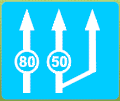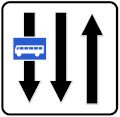Road signs in Iran
Road signs in Iran are regulated by both INSO standard 14815-1 and 14815-2.[1][2] They generally follow the Vienna Convention on Road Signs and Signals and their designs both influenced by British and German road signage designs.
Road signs are divided in three categories:
- Regulatory signs;
- Warning signs;
- Information signs.
Iran signed the Vienna Convention on Road Signs and Signals on November 8, 1968 and ratified it on May 21, 1976.[3]
Warning signs
-
 Warning for bends
Warning for bends -
 Bend to the right
Bend to the right -
 Bend to the left
Bend to the left -
 Double bend, first to the right
Double bend, first to the right -
 Double bend, first to the left
Double bend, first to the left -
 Junction
Junction -
 Crossroad with priority
Crossroad with priority -
 Side road with priority from the right
Side road with priority from the right -
 Side road with priority from the left
Side road with priority from the left -
 Roundabout
Roundabout -
 Dangerous descent (10%)
Dangerous descent (10%) -
 Dangerous climb (10%)
Dangerous climb (10%) -
 Road narrows (both sides)
Road narrows (both sides) -
 Road narrows (right side)
Road narrows (right side) -
 Uneven road
Uneven road -
 Caution, speed bump
Caution, speed bump -
 Danger of skidding
Danger of skidding -
 Two-way traffic
Two-way traffic -
 Traffic light
Traffic light -
 Animals (domesticated)
Animals (domesticated) -
 Wild animals
Wild animals -
 Crosswind
Crosswind -
 Loose gravel
Loose gravel -
 Rockfall
Rockfall -
 Pedestrian crossing ahead
Pedestrian crossing ahead -
 Pedestrians
Pedestrians -
 Children
Children -
 School
School -
 Caution for bicyclists
Caution for bicyclists -
 Aircraft (landing corridor above road)
Aircraft (landing corridor above road) -
 Caution, tunnel
Caution, tunnel -
 Other hazard
Other hazard -
 Caution, queues likely
Caution, queues likely -
 Be careful in winter
Be careful in winter -
 Tramway
Tramway -
 Caution, fog likely
Caution, fog likely -
 Caution, accident black spot
Caution, accident black spot -
 Soft verge
Soft verge -
 Level crossing with gates or barriers
Level crossing with gates or barriers -
 Level crossing without gates or barriers
Level crossing without gates or barriers -
 Distance marker (150 m)
Distance marker (150 m) -
 Distance marker (100 m)
Distance marker (100 m) -
 Distance marker (50 m)
Distance marker (50 m) -
 Warning, single-track railway crossing
Warning, single-track railway crossing -
 Warning, multiple-track railway crossing
Warning, multiple-track railway crossing
Priority signs
-

-
 Give way/yield
Give way/yield -
 Priority road
Priority road -
 End of priority road
End of priority road -
 Priority before the oncoming traffic
Priority before the oncoming traffic -
 Priority of the oncoming traffic
Priority of the oncoming traffic
Prohibitive or restrictive signs
-
 Road closed to all vehicles in both directions
Road closed to all vehicles in both directions -
 No entry
No entry -
 No right turn
No right turn -
 No left turn
No left turn -
 No U-turn
No U-turn -
 No cars
No cars -
 No lorries
No lorries -
 No buses
No buses -
 No tractors
No tractors -
 No motorcycles
No motorcycles -
 No cycling
No cycling -
 No animal-drawn vehicles
No animal-drawn vehicles -
 No handcarts
No handcarts -
 No motor vehicles
No motor vehicles -
 No entry for motorised or animal-drawn vehicles
No entry for motorised or animal-drawn vehicles -
 No vehicles heavier than indicated
No vehicles heavier than indicated -
 No vehicles with axle weight greater than indicated
No vehicles with axle weight greater than indicated -
 No vehicles wider than indicated
No vehicles wider than indicated -
 No vehicles taller than indicated
No vehicles taller than indicated -
 No vehicles or combinations longer than indicated
No vehicles or combinations longer than indicated -
 No vehicles carrying hazardous cargo
No vehicles carrying hazardous cargo -
 No vehicles carrying water-polluting cargo
No vehicles carrying water-polluting cargo -
 Speed limit (80 km/h)
Speed limit (80 km/h) -
.svg.png) End of speed limit
End of speed limit -
 No overtaking
No overtaking -
 End of no-overtaking zone
End of no-overtaking zone -
 No overtaking by lorries
No overtaking by lorries -
 End of no-overtaking zone for lorries
End of no-overtaking zone for lorries -
 No use of audible warning signals
No use of audible warning signals -
 End of all prohibitions
End of all prohibitions -
 Stop to pay toll duty
Stop to pay toll duty -
 No stopping
No stopping -
 No parking
No parking -
 No pedestrians
No pedestrians -
 No animal riders
No animal riders -
 No vehicles towing trailers
No vehicles towing trailers -
 Safe distance (70 m)
Safe distance (70 m)
Mandatory signs
-
 Ahead only
Ahead only -
 Turn right ahead
Turn right ahead -
 Turn left ahead
Turn left ahead -
 Turn right here
Turn right here -
 Turn left here
Turn left here -
 Keep right
Keep right -
 Keep left
Keep left -
 Pass either side
Pass either side -
 Ahead or right only
Ahead or right only -
 Ahead or left only
Ahead or left only -
 Turn left or right
Turn left or right -
 One way
One way -
 Roundabout
Roundabout -
 Snow chains compulsory
Snow chains compulsory -
.svg.png) Minimum speed limit
Minimum speed limit -
.svg.png) End of minimum speed limit
End of minimum speed limit -
 Pedestrian zone
Pedestrian zone -
 Cycleway
Cycleway -
 Route for animal riders (bridleway)
Route for animal riders (bridleway)
Traffic regulation
-
 Freeway marker
Freeway marker -
 Expressway marker
Expressway marker -
 Road marker
Road marker -
 Street marker
Street marker -
 Avenue and boulevard marker
Avenue and boulevard marker -
 Roundabout marker
Roundabout marker -
 Sign ahead plaque (200 m, on top of the all signs)
Sign ahead plaque (200 m, on top of the all signs) -
 Sign ahead plaque (2 km, on top of the all signs)
Sign ahead plaque (2 km, on top of the all signs) -
 Different speed limitations in several roads
Different speed limitations in several roads -
 Minimum speed in different lanes
Minimum speed in different lanes -
 Bus lane ahead
Bus lane ahead -
 Vehicles carrying hazardous cargo turn left
Vehicles carrying hazardous cargo turn left -
 Directional sign
Directional sign -
 Pedestrian crossing
Pedestrian crossing
Temporary signs
-
 Road narrows (both sides)
Road narrows (both sides) -
 Uneven road
Uneven road -
 Danger of skidding
Danger of skidding -
 Two-way traffic
Two-way traffic -
 Traffic light
Traffic light -
 Roadworks
Roadworks -
 Loose gravel
Loose gravel -
 Soft verge
Soft verge -
 Other dangers
Other dangers
Route shields
-
 Freeway
Freeway -
 Highway
Highway
References
- ^ "استاندارد-ملی-علائم-14815-1" (PDF). imentaraddod.com (in Persian). 2013.
- ^ "استاندارد-ملی-علائم-14815-2" (PDF). shaghool.ir (in Persian). 2013. Retrieved 31 May 2025.
- ^ "United Nations Treaty Collection". treaties.un.org. Retrieved 2023-11-21.